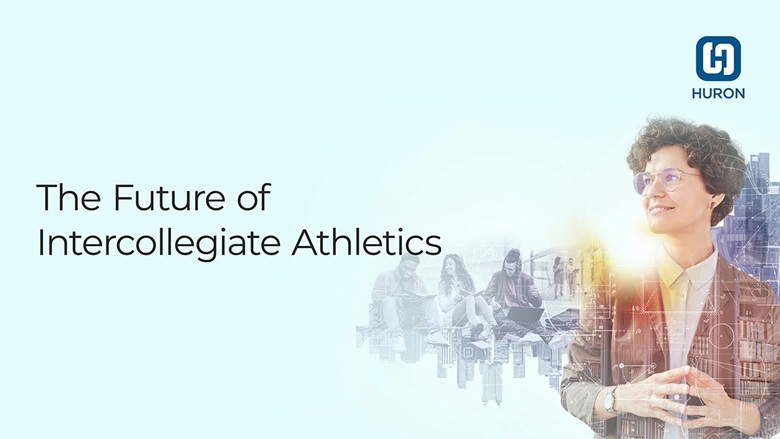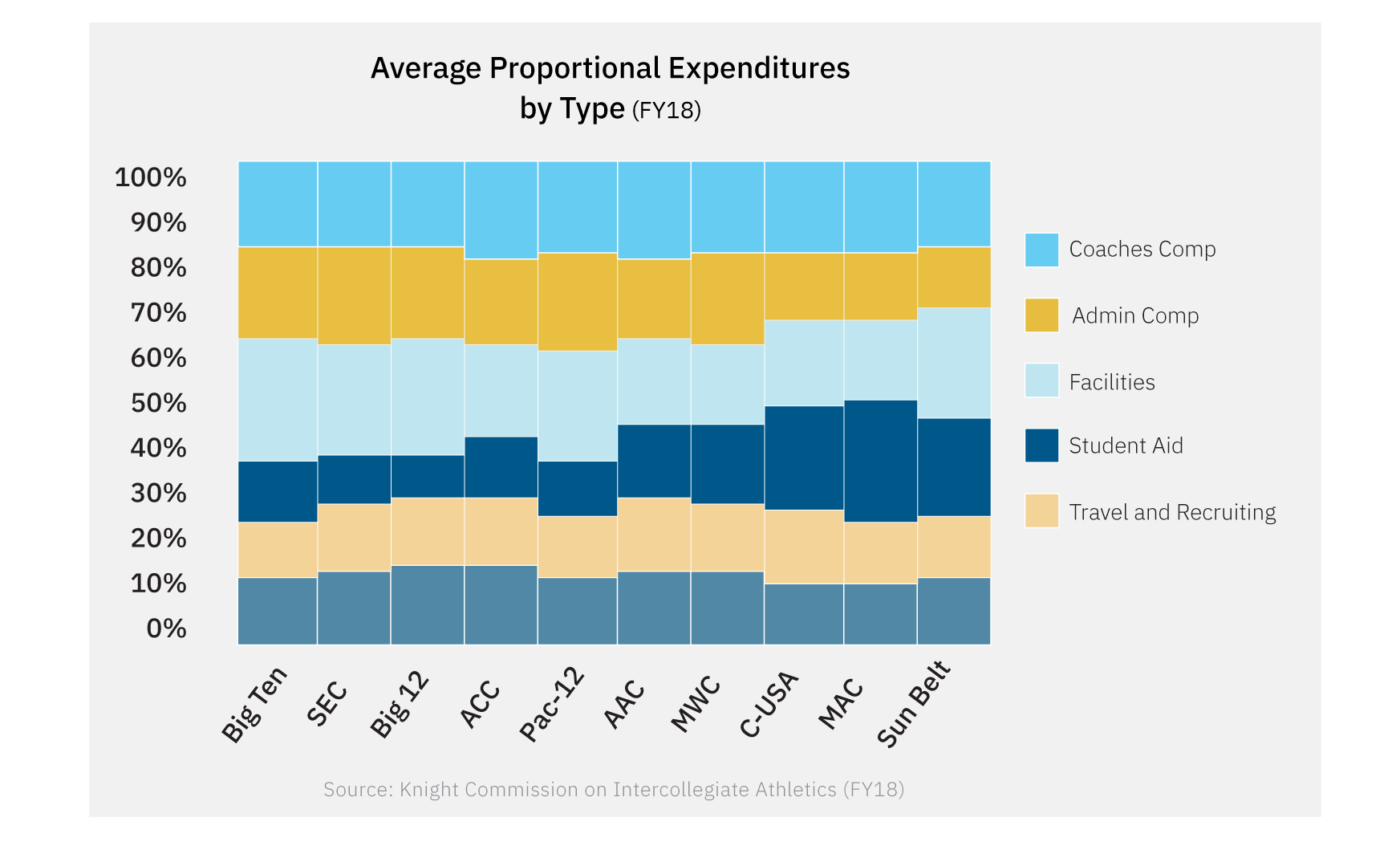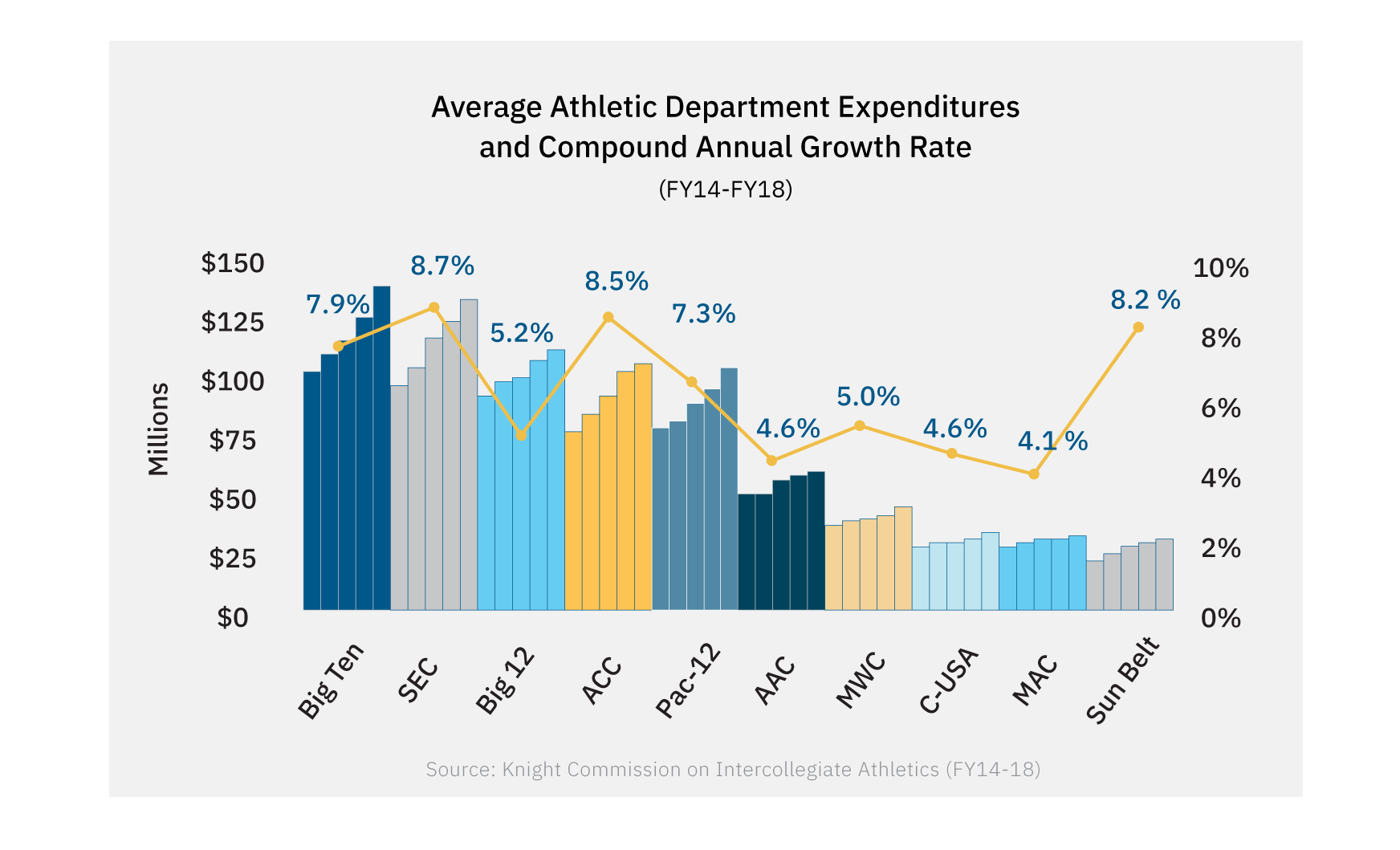In Brief
In this webinar, leaders from the field of intercollegiate athletics discuss the benefits and risks of athletic programs in terms of brand visibility, enrollment, student experience, campus culture, alumni engagement and fundraising.
Watch the recording for a lively and interactive discussion on the evolving nature of intercollegiate athletics programs, featuring:
- Sandy Barbour, Vice President for Intercollegiate Athletics, Penn State University
- Bob Bowlsby, Commissioner, Big 12 Conference
- Jim Delany, Former Commissioner, Big Ten Conference
- Donde Plowman, Chancellor, The University of Tennessee, Knoxville
- Stan Wilcox, Executive Vice President, Regulatory Affairs, NCAA
- Tim Walsh, Managing Director, Huron

The field of intercollegiate athletics is under enormous stress due to competitive and financial pressures, pending litigation, potential regulatory actions, and concerns about diversity and equity. Despite these pressures, intercollegiate athletic departments and the programs within them remain key enablers as institutions and communities seek to emerge from the pandemic stronger than before. High-profile programs in particular continue to have substantial impacts on the reputation, culture and financial health of their institutions.
Panelists from the March 24 webinar, “Strategies for Intercollegiate Athletics in a New Age of Uncertainty,” hosted by Huron and The Chronicle of Higher Education, provided an array of perspectives on the field of intercollegiate athletics, presenting a well-articulated case for evolution in this space.
“We are at an inflection point in intercollegiate athletics,” said Jim Delany, the former commissioner of the Big Ten Conference and a panelist at the event. “It's important to understand [that the change that’s needed] is not going to happen in a day. My hope is that through a process of creative collaboration and understanding the mission, we will be able to make the changes that are necessary, and the young people in the next generation will be beneficiaries.”
The following themes emerged throughout the March 24 webinar.
Aligning Athletics With the Institutional Mission
Many institutions are reassessing how various campus constituents, including their athletic programs, support their overall mission.
Donde Plowman, chancellor of the University of Tennessee, Knoxville, said:
When organizations face uncertainty and ambiguity, the thing that holds them together and helps them move forward is having really clear alignment on what their values are and what the mission is. COVID-19 taught us a lot about how to do that. For example, if I am at a public university where our driving purpose and mission is to serve this state, how does the athletics department help us do that?
Plowman went on:
When [both the academic and athletic teams] sit at the table together, it helps with some of these future decisions and being aligned on purpose. There are so many different possible missions for an athletic department. If the mission is to win national championships … brand the university … help students get a good education while they’re playing sports, that's going to drive a different set of actions and behaviors. [Yet we are] one university, one brand, one mission, and we need to not only be in alignment but symbolize that alignment.
Stan Wilcox, executive vice president for regulatory affairs at the NCAA, reiterated that all universities have a responsibility to ensure that student-athletes are affirming the institutional mission in the arena and the classroom:
What’s unique about [intercollegiate athletics] is that you are trying to create the best possible student-athlete experience you can, but at the same time, you also have to make sure [student-athletes] understand how they need to be in alignment with the university. Student-athletes need to not forget that they have to compete just as hard in the classroom as they compete on the playing field. It is about getting an education.
The Need for a More Sustainable Business Model for Intercollegiate Athletics
With respect to the financial challenges facing many athletic departments and the financial disparities that may impact the competitive environment over time, the panelists agreed that it is difficult to envision a viable solution for all schools.
“We have to understand that there are legitimate differences in what works for schools,” said Bob Bowlsby, commissioner of the Big 12 Conference. “Can you expect 350 institutions with disparate characteristics to functionally come [together] with good outcomes? I think that is the key question of sustainability.”

Delany said:
[Intercollegiate athletics] needs to be able to address financial discipline in a way that we have not been able to do. It is true that some institutions and conferences have more resources, [but] the answer is not necessarily sharing that revenue. It is ensuring that that revenue is appropriately spent on opportunities for young people, that it is not misspent.
Redefining Success in Intercollegiate Athletics
Athletic programs benefit their campuses in a variety of ways, but many are difficult to measure. To redefine success for each program, leaders must prioritize accounting for the broad impacts of intercollegiate athletics on various institutional goals — including enrollment, alumni engagement, and local economic development.
Sandy Barbour, vice president for intercollegiate athletics at The Pennsylvania State University, said:
What is the objective of having an intercollegiate athletics program? How does campus view and quantify the value of having intercollegiate athletics? I think there needs to be true understanding of the value that intercollegiate athletics brings to campus. Athletics can certainly be an enrollment or tuition driver to varying degrees, but I think, as we look at the cost of these programs and their sustainability, [we need] a true economic analysis of what is the cost of athletics, as opposed to just a balance sheet.
The panelists consistently emphasized the broad impacts of athletic programs and student outcomes. In addition to quantifiable contributions like tuition and enrollment growth, intercollegiate athletics creates valuable opportunities for nonathletes through things like bands, cheer and athletic training. They also cultivate the next generation of leaders by giving student athletes a great education alongside their athletic and leadership experience. The events of the past year highlighted this leadership potential — and how that not only benefits the institution and the individual, but also the greater community.
“What would the world be like if we looked at our student-athletes as the next series of leaders in our country? COVID-19 taught me this: They came back first. They adhered to the protocols. They have modeled inclusive excellence,” Plowman said. “I would like to think about that as a different frame for thinking about athletics.”
KEY TAKEAWAYS
-
Think differently.
Reflect on how student-athletes and the athletic department contribute both directly and indirectly to institutional success. -
Plan differently.
Create an objective set of financial metrics and forward-looking plans that would be systematically updated so that investments in athletics are deliberate and driven by transparent data. -
Act differently.
Communicate the true value of athletic programs at the institution, using qualitative and quantitative data, to help various stakeholders understand how athletics supports the institution’s academic mission and core values.

